Kenneth Atchity's Blog, page 226
October 22, 2012
Use The Book Trailer Where It Has The Greatest Effect
By Lance Robbins, Story Merchant Book Marketing, former head of
Fox Family Films

The first and most effective place to promote your trailer is on YouTube, as
this will ensure as many readers see it as possible.
Next, you can add your video trailer to your Goodreads author profile page – this can set you apart from
all the other authors on there, most of whom are not taking advantage of
this. Amazon also allow you upload videos to Amazon Author Central
– provided you stick to their rules.
Finally, make sure you embed the Youtube video trailer on your own author
blog too. (You can even direct agents and publishers to it there, if
you’re taking the traditional print publishing pathway – this will give you a huge
advantage over most other authors seeking similar deals.)

Published on October 22, 2012 00:00
October 19, 2012
Listen to My Podcast on Larry Thompson's Thriller Thursday
THRILLER THURSDAYS PODCAST 3
The state of publishing and how it affects authors today

Podcast: Play in new window
| Download
Special Guest: Ken Atchity, Story Merchant
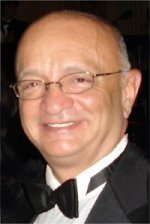 With more than forty years experience in the publishing world, and
With more than forty years experience in the publishing world, and
twenty years in entertainment, Dr. Ken Atchity is a self-defined “story
merchant” – writer, producer, career coach, teacher, and literary
manager, responsible for launching dozens of books and films. His life’s
passion is finding great storytellers and turning them into bestselling
authors and screenwriters.
Today he joins Larry Thompson and Dave Dufour to talk about the
changes in the publishing industry, along with his new venture, Story
Merchant Books, which helps emerging writers get published
electronically, among many other services. Join us for some stimulating
conversation!
Ken’s Websites
The Story Merchant & Story Merchant Books – http://www.storymerchant.com
Ken’s Blog - http://www.kenatchityblog.com/
Story Merchant Book Marketing - http://storymerchantbookmarketing.com/
Story Merchant News Desk – http://kenatchity.com/

The state of publishing and how it affects authors today

Podcast: Play in new window
| Download
Special Guest: Ken Atchity, Story Merchant
 With more than forty years experience in the publishing world, and
With more than forty years experience in the publishing world, and twenty years in entertainment, Dr. Ken Atchity is a self-defined “story
merchant” – writer, producer, career coach, teacher, and literary
manager, responsible for launching dozens of books and films. His life’s
passion is finding great storytellers and turning them into bestselling
authors and screenwriters.
Today he joins Larry Thompson and Dave Dufour to talk about the
changes in the publishing industry, along with his new venture, Story
Merchant Books, which helps emerging writers get published
electronically, among many other services. Join us for some stimulating
conversation!
Ken’s Websites
The Story Merchant & Story Merchant Books – http://www.storymerchant.com
Ken’s Blog - http://www.kenatchityblog.com/
Story Merchant Book Marketing - http://storymerchantbookmarketing.com/
Story Merchant News Desk – http://kenatchity.com/

Published on October 19, 2012 09:06
My Addiction Books ReviewsThe Messiah Matrix
NOVEL REVIEW: MESSIAH MATRIX
Messiah
Matrix can be noted as a high- minded novel which draws readers into a
world filled with corruption, murder, romance and history. The author,
Kenneth John Atchity explores a highly controversial idea about the
story of Jesus Christ.
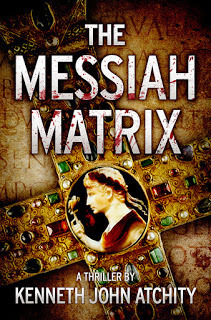
Atchity’s
extensive research manages to compel the reader’s attention within the
first two pages as the novel kicks off with the murder of a monsignor, a
confession from his killer and the discovery of a valuable artefact
which might just change our understanding of Christianity as we know it.
Readers
are drawn into the mind of Father Ryan, a young Jesuit priest who is
obsessed in finding the connection between the murders, the message
which was delivered by the assassin and his own personal doubts about
his religious faith. By questioning the inconsistencies within the
Catholic teachings his path crosses that off Emily – a spirited beauty
who is the discoverer of the historical artefact.
Together
they set off on a journey that not only unravels Christian history but
also poses extreme risks for them in face of church authorities. Their
findings cast them into a splendidly crafted net that lures readers
through Roman History and the ancient story of Augustus. It ends with
the truth revealed about the Christian Saviour—one which will come as a
surprise to many.
In conclusion: This
novel, in my opinion is splendid. The storytelling accelerates in
momentum and grabbed my attention from the word go. Sure, there were
times where my brain was in panic from all the revelations, but there
were also times where the pages just turned themselves from the riveting
adventure.
I’m
sure the story will raise many questions for people who grew up in deep
faith. What’s nice about Atchity’s writing though is the fact that he
doesn’t force readers into believing in the book’s premise; instead he
merely lays out his research, marvellously joining it together in a
provocatively crafted romantic thriller.
Not a light read at all but if you are up for intellectual entertainment - a must read.

Messiah
Matrix can be noted as a high- minded novel which draws readers into a
world filled with corruption, murder, romance and history. The author,
Kenneth John Atchity explores a highly controversial idea about the
story of Jesus Christ.

Atchity’s
extensive research manages to compel the reader’s attention within the
first two pages as the novel kicks off with the murder of a monsignor, a
confession from his killer and the discovery of a valuable artefact
which might just change our understanding of Christianity as we know it.
Readers
are drawn into the mind of Father Ryan, a young Jesuit priest who is
obsessed in finding the connection between the murders, the message
which was delivered by the assassin and his own personal doubts about
his religious faith. By questioning the inconsistencies within the
Catholic teachings his path crosses that off Emily – a spirited beauty
who is the discoverer of the historical artefact.
Together
they set off on a journey that not only unravels Christian history but
also poses extreme risks for them in face of church authorities. Their
findings cast them into a splendidly crafted net that lures readers
through Roman History and the ancient story of Augustus. It ends with
the truth revealed about the Christian Saviour—one which will come as a
surprise to many.
In conclusion: This
novel, in my opinion is splendid. The storytelling accelerates in
momentum and grabbed my attention from the word go. Sure, there were
times where my brain was in panic from all the revelations, but there
were also times where the pages just turned themselves from the riveting
adventure.
I’m
sure the story will raise many questions for people who grew up in deep
faith. What’s nice about Atchity’s writing though is the fact that he
doesn’t force readers into believing in the book’s premise; instead he
merely lays out his research, marvellously joining it together in a
provocatively crafted romantic thriller.
Not a light read at all but if you are up for intellectual entertainment - a must read.

Published on October 19, 2012 00:00
October 17, 2012
The Houston Lawyer Reviews Larry D. Thompson's Dead Peasants

Book Review
Dead Peasants
Author: Larry D. Thompson
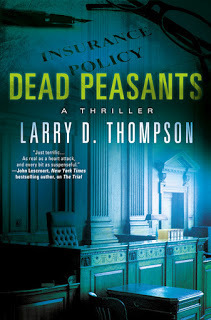
Publisher: Thomas Dunne Books
ISBN: 9781250009494
292 pages
Dead Peasants is part courtroom drama, part romance, and part thriller. Most of all, this is a well-written story that is hard to put down once you open the first page. Dead Peasants is the third novel by Houston attorney Larry D. Thompson, a partner at Lorance & Thompson, P.C., who draws on decades of his legal experience to construct this highly credible page-turner.
The thriller’s main character is Jackson “Jack” Douglas Bryant, an old-school plaintiff’s lawyer—one like so many plaintiff’s lawyers we have known or at least heard about. After a considerably large verdict, Jack decides to retire from his Beaumont practice and relocate to his childhood hometown of Fort Worth. However, it does not take long before Jack gets restless in retirement, and he begins taking on some pro bono cases out of an office he sets up in his luxury RV.
June Davis, one of Jack’s pro bono clients, is a recent widow, who had lost her husband, Willie, of over 50 years. One day June stops by the RV with a check in hand for $400,000, made payable to Willie’s former employer, a car dealership. The post office had accidentally mangled the cover letter and delivered it to her because hers was the only name that they could make out. June and Jack think the large check is quite odd, considering that Willie had retired 15 years earlier, and earned only $20,000 a year as a porter for the car dealership.
With the post office’s help, June unwittingly discovers what the insurance industry calls a “dead peasant policy.” In their heyday, from the 1980s to early 2000s, some employers would purchase life insurance policies on their low-paid rank-and-file employees without ever telling them. The employers would frequently keep paying the low premiums even after the employees retire or quit. When the covered person dies, the company would cash in on the insurance proceeds, with frequently no money from the payout going to the grieving family. When the public became aware of dead peasant policies, there was such an outcry that many companies stopped buying the policies and most states, like Texas, outlawed them.
Jack quickly puts his litigation skills to work and the stakes literally turn into life and death. His initial thought that the case involved only one policy proves wrong, as he uncovers that Willie’s prominent former employer had actually taken out policies on hundreds of other former employees. Further investigation reveals that several of these “peasants” turned up dead over a few short months with unexplained circumstances. When Jack starts turning over too many stones, he is threatened and finds himself amidst a plot that reaches far more than his own personal security and threatens his paramour’s life.
Revealing much more of the plot line will compromise the suspenseful aspect of this story. Suffice it to say, this is a must-read for lovers of legal thrillers. And the fact that it is set in the familiar settings of Fort Worth and Texas law makes it all the more enjoyable.
Robert Painter is a trial lawyer with the Painter Law Firm PLLC, where he handles medical malpractice cases for plaintiffs. He is an associate editor of The Houston Lawyer.

Published on October 17, 2012 00:00
October 16, 2012
A witness to history
Former Secret Service agent talks about N.D. & Jacqueline Kennedy
By ELOISE OGDEN - Regional Editor (eogden@minotdailynews.com)
,
Minot Daily News
Nearly 49 years ago, former Secret Service agent Clint Hill leaped onto the back of the presidential limousine in Dallas to protect those in the car as it raced for a hospital with President John F. Kennedy, who had been fatally wounded by a sniper.
It was Nov. 22, 1963.
Hill was First Lady Jacqueline Kennedy's Secret Service agent, and in videos taken that day can be seen climbing aboard the back of the presidential limousine after assassin Lee Harvey Oswald shot the president from the window of an office building in downtown Dallas.

Eloise Ogden/MDN
Former Secret Service agent Clint Hill, third from left, shakes hands Monday with David Fuller, president of Minot State University, after Hill stepped off a plane at the Minot International Airport. David Reiten, president of the Norsk Hostfest Association, is at far left. At right are author Lisa McCubbin, who co-wrote with Hill the book, “Mrs. Kennedy and Me,” and Myron Thompson, Minot. Hill will be inducted in the Norsk Hostfest Scandinavian-American Hall of Fame Wednesday. Fuller is Hill’s host while in Minot.
This week, the North Dakota native is in Minot for Norsk Hostfest activities. He'll be inducted Wednesday into the Norsk Hostfest Scandinavian-American Hall of Fame.
Hill and Lisa McCubbin, who accompanied him to Minot, are the co-authors of the new book, "Mrs. Kennedy and Me."
Hill's parents homesteaded in the Roseglen area. Hill, 80, was born at Larimore and then placed in an orphanage in Fargo. He was adopted when he was 3 months old by Chris and Jennie Hill, who brought him to Washburn. There, he attended school, graduating from Washburn High School. He went to Concordia College in Moorhead, Minn.
Hill has fond memories about his North Dakota upbringing, including visits to Minot.
He said his mother's birthday was July 4 and that month he remembers the family would come to Minot to the State Fair.
"All of her family all of her sisters and brothers whoever lived in the area would meet us here at a park near the fairgrounds. Everybody would bring something and we'd have a big picnic and then everybody would go to the State Fair," he said in an interview Monday afternoon.
After his father died, Hill said his mother moved to Minot. At the time of her death, she was living in a nursing home in Northwood because his sister lived on a farm near there. The funeral was held in Minot.
Hill's Secret Service career included working for several presidents.
Hill said when Vice President Spiro Agnew visited Minot he also visited Hill's mother here. He recalled it was during the campaign of 1972 when he was the assistant director for all protective forces for the Secret Service in Washington, D.C.
"One of the advance agents for the vice president was here in Minot setting up the trip and he called and said, 'Would it be OK if the vice president stopped by and saw your mother?' I knew the Agnews. I had been with the Agnews for awhile," Hill said. He told the agent that was fine if the vice president paid a visit to his mother.
"I arranged for my mother to be at my cousin's house, Paul and Olga Froemming, and vice president Agnew came here and met my mother there. It was on the front page of The Minot Daily News," Hill said.
He recalls being in North Dakota on official business once with Agnew to Fargo. Another time he did an advance trip through here for Lyndon Johnson but the decision then was made that Johnson wouldn't stop here. Hill recalls that trip was so secretive that Hill couldn't even go see his mother.
McCubbin said Hill talks about his boyhood in North Dakota in the book to show how different his upbringing was in contrast to Jacqueline Kennedy.
The book contains photographs of his family and his boyhood home, which was in the east end of the Washburn.
"There were 912 people living there at that time," he said.
McCubbin, who now lives in Alexandria, Va., where Hill has lived for many years, said they became acquainted when she was working on another book, "The Kennedy Detail." She said that book was with another Secret Service agent who had been with President Kennedy.
"We needed Clint's help for the book," McCubbin said. She said the other agent introduced her to Hill.
"Clint was very hesitant because he hadn't provided any information to any other books, but he trusted this other agent and then he slowly began to trust me. He revealed a lot of information for the other book. We became very close and then throughout the course of the next year we were together a lot promoting the other book. I'd asked him if he would ever consider writing a book and he said, 'No way, never, never.'" McCubbin said.
"I vowed I'd never write a book," Hill added.
"But then the publisher came to us and asked if we would do this book together," McCubbin said. "He decided it was historical information as long as we would do it in such a way that it was a tribute to Jacqueline nothing salacious, gossip or rumors but a tribute to the woman that he admired and respected, then he would agree to do it."
The book was released April 3 and was on the New York Times bestseller list for 14 weeks, McCubbin said.
"It's been very well received," she added.
Hill talked about Jacqueline Kennedy and how they addressed each other.
"Mrs. Kennedy and she called me Mr. Hill, with never any variation," he said.
"She was extremely intelligent, very athletic. She was an expert horsewoman, loved to play tennis and water ski. She was a hands-on mom, really dedicated to those two children, Caroline and John, and she was a devoted wife to her husband. (She) tried everything she could to give the president a relaxing atmosphere whenever possible so that he could get away a little bit from the stress and strains of the office. That was her goal and to really keep things private as much as possible. She emphasized that all the time," Hill said.
"She was just a wonderful lady. She had a wonderful sense of humor and she was a pleasure to be around to work with," he said. "She was a down-to-earth human being."
McCubbin said Hill also agreed to write the book because he realized that people didn't really know who Jacqueline Kennedy was.
"He knew her like nobody else did. There had been so many books written about her with lot of falsehoods," McCubbin said.
He said many people who wrote about Jacqueline Kennedy never knew her. "They were friends of friends of friends they got information from," he said.
Hill said he knew Jacqueline Kennedy from after the election of 1960 until after the election of 1964.
"He was with her constantly," McCubbin said.
From this book, Hill said he wants people "to understand who she was and what she was really like. That she was someone they could really relate to and be proud of."
"It's really his memoir of really happy times and tragic times that changed America, and he was right there in the middle of it," McCubbin said.
"One thing that I wanted to do in the book was give people a sense of who he is. He talks about how his North Dakota roots really contributed to everything he did in his life," McCubbin said.
"The values that I learned as a child, they're the ones that I still have today," Hill said.
In regard to Oswald, who shot President Kennedy, Hill said Oswald was a loner and loser "because he just couldn't get along with people, couldn't keep a job, couldn't even successfully defect to the Soviet Union. They didn't want him either. He was just someone trying to make a name for himself apparently, and that's want he did, but he didn't live to relish in his fame, so to speak."
Hill and McCubbin have been traveling since April on a book tour. They recently returned from Italy. They'll go to Australia in February.
"So it's international," Hill said of his book.
He said Jacqueline Kennedy always was international. He accompanied her to France, Greece, India, Pakistan and all over South America.
Will they write another book?
"Maybe," Hill replied, adding, "There's always more stories."
"We're really honored that Hostfest has invited us and is honoring Clint," McCubbin said. She said many North Dakota people have contacted them, asking him to return to North Dakota to speak. They said Norsk Hostfest is a great opportunity for them to be here.
[image error]
©
Copyright 2012 Minot Daily News. All rights reserved. This material may
not be published, broadcast, rewritten or redistributed.


By ELOISE OGDEN - Regional Editor (eogden@minotdailynews.com)
,
Minot Daily News
Nearly 49 years ago, former Secret Service agent Clint Hill leaped onto the back of the presidential limousine in Dallas to protect those in the car as it raced for a hospital with President John F. Kennedy, who had been fatally wounded by a sniper.
It was Nov. 22, 1963.
Hill was First Lady Jacqueline Kennedy's Secret Service agent, and in videos taken that day can be seen climbing aboard the back of the presidential limousine after assassin Lee Harvey Oswald shot the president from the window of an office building in downtown Dallas.

Eloise Ogden/MDN
Former Secret Service agent Clint Hill, third from left, shakes hands Monday with David Fuller, president of Minot State University, after Hill stepped off a plane at the Minot International Airport. David Reiten, president of the Norsk Hostfest Association, is at far left. At right are author Lisa McCubbin, who co-wrote with Hill the book, “Mrs. Kennedy and Me,” and Myron Thompson, Minot. Hill will be inducted in the Norsk Hostfest Scandinavian-American Hall of Fame Wednesday. Fuller is Hill’s host while in Minot.
This week, the North Dakota native is in Minot for Norsk Hostfest activities. He'll be inducted Wednesday into the Norsk Hostfest Scandinavian-American Hall of Fame.
Hill and Lisa McCubbin, who accompanied him to Minot, are the co-authors of the new book, "Mrs. Kennedy and Me."
Hill's parents homesteaded in the Roseglen area. Hill, 80, was born at Larimore and then placed in an orphanage in Fargo. He was adopted when he was 3 months old by Chris and Jennie Hill, who brought him to Washburn. There, he attended school, graduating from Washburn High School. He went to Concordia College in Moorhead, Minn.
Hill has fond memories about his North Dakota upbringing, including visits to Minot.
He said his mother's birthday was July 4 and that month he remembers the family would come to Minot to the State Fair.
"All of her family all of her sisters and brothers whoever lived in the area would meet us here at a park near the fairgrounds. Everybody would bring something and we'd have a big picnic and then everybody would go to the State Fair," he said in an interview Monday afternoon.
After his father died, Hill said his mother moved to Minot. At the time of her death, she was living in a nursing home in Northwood because his sister lived on a farm near there. The funeral was held in Minot.
Hill's Secret Service career included working for several presidents.
Hill said when Vice President Spiro Agnew visited Minot he also visited Hill's mother here. He recalled it was during the campaign of 1972 when he was the assistant director for all protective forces for the Secret Service in Washington, D.C.
"One of the advance agents for the vice president was here in Minot setting up the trip and he called and said, 'Would it be OK if the vice president stopped by and saw your mother?' I knew the Agnews. I had been with the Agnews for awhile," Hill said. He told the agent that was fine if the vice president paid a visit to his mother.
"I arranged for my mother to be at my cousin's house, Paul and Olga Froemming, and vice president Agnew came here and met my mother there. It was on the front page of The Minot Daily News," Hill said.
He recalls being in North Dakota on official business once with Agnew to Fargo. Another time he did an advance trip through here for Lyndon Johnson but the decision then was made that Johnson wouldn't stop here. Hill recalls that trip was so secretive that Hill couldn't even go see his mother.
McCubbin said Hill talks about his boyhood in North Dakota in the book to show how different his upbringing was in contrast to Jacqueline Kennedy.
The book contains photographs of his family and his boyhood home, which was in the east end of the Washburn.
"There were 912 people living there at that time," he said.
McCubbin, who now lives in Alexandria, Va., where Hill has lived for many years, said they became acquainted when she was working on another book, "The Kennedy Detail." She said that book was with another Secret Service agent who had been with President Kennedy.
"We needed Clint's help for the book," McCubbin said. She said the other agent introduced her to Hill.
"Clint was very hesitant because he hadn't provided any information to any other books, but he trusted this other agent and then he slowly began to trust me. He revealed a lot of information for the other book. We became very close and then throughout the course of the next year we were together a lot promoting the other book. I'd asked him if he would ever consider writing a book and he said, 'No way, never, never.'" McCubbin said.
"I vowed I'd never write a book," Hill added.
"But then the publisher came to us and asked if we would do this book together," McCubbin said. "He decided it was historical information as long as we would do it in such a way that it was a tribute to Jacqueline nothing salacious, gossip or rumors but a tribute to the woman that he admired and respected, then he would agree to do it."
The book was released April 3 and was on the New York Times bestseller list for 14 weeks, McCubbin said.
"It's been very well received," she added.
Hill talked about Jacqueline Kennedy and how they addressed each other.
"Mrs. Kennedy and she called me Mr. Hill, with never any variation," he said.
"She was extremely intelligent, very athletic. She was an expert horsewoman, loved to play tennis and water ski. She was a hands-on mom, really dedicated to those two children, Caroline and John, and she was a devoted wife to her husband. (She) tried everything she could to give the president a relaxing atmosphere whenever possible so that he could get away a little bit from the stress and strains of the office. That was her goal and to really keep things private as much as possible. She emphasized that all the time," Hill said.
"She was just a wonderful lady. She had a wonderful sense of humor and she was a pleasure to be around to work with," he said. "She was a down-to-earth human being."
McCubbin said Hill also agreed to write the book because he realized that people didn't really know who Jacqueline Kennedy was.
"He knew her like nobody else did. There had been so many books written about her with lot of falsehoods," McCubbin said.
He said many people who wrote about Jacqueline Kennedy never knew her. "They were friends of friends of friends they got information from," he said.
Hill said he knew Jacqueline Kennedy from after the election of 1960 until after the election of 1964.
"He was with her constantly," McCubbin said.
From this book, Hill said he wants people "to understand who she was and what she was really like. That she was someone they could really relate to and be proud of."
"It's really his memoir of really happy times and tragic times that changed America, and he was right there in the middle of it," McCubbin said.
"One thing that I wanted to do in the book was give people a sense of who he is. He talks about how his North Dakota roots really contributed to everything he did in his life," McCubbin said.
"The values that I learned as a child, they're the ones that I still have today," Hill said.
In regard to Oswald, who shot President Kennedy, Hill said Oswald was a loner and loser "because he just couldn't get along with people, couldn't keep a job, couldn't even successfully defect to the Soviet Union. They didn't want him either. He was just someone trying to make a name for himself apparently, and that's want he did, but he didn't live to relish in his fame, so to speak."
Hill and McCubbin have been traveling since April on a book tour. They recently returned from Italy. They'll go to Australia in February.
"So it's international," Hill said of his book.
He said Jacqueline Kennedy always was international. He accompanied her to France, Greece, India, Pakistan and all over South America.
Will they write another book?
"Maybe," Hill replied, adding, "There's always more stories."
"We're really honored that Hostfest has invited us and is honoring Clint," McCubbin said. She said many North Dakota people have contacted them, asking him to return to North Dakota to speak. They said Norsk Hostfest is a great opportunity for them to be here.
[image error]
©
Copyright 2012 Minot Daily News. All rights reserved. This material may
not be published, broadcast, rewritten or redistributed.

Published on October 16, 2012 00:00
October 15, 2012
Studies of Ancient Gold Artifacts Weaved into New Novel By Terry Stanfill
Filed under Culture |
Posted by The Silo
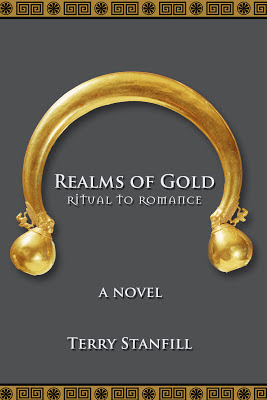
If ever gold was precious, it’s now. “Gold has remained at or near record high prices , even while the value of other commodities falls,” notes art expert Terry Stanfill, author of Realms of Gold: Ritual to Romance www.realmsofgoldthenovel.blogspot.com , a book that blends factual ancient art and history with modern, fictional romance.
“This past summer, we were all about the gold – our athletes’ gold medals, which, by the way, had the highest value of any Olympic gold medals in history at $708.”
More than two-thirds of the world’s gold demand is for jewelry, she says, of which the United States is the third-largest consumer, behind India and China.
But Stanfill, who studies ancient gold artifacts and weaves them into her newest novel, says we are hardly the first to become enamored of the rare yellow metal.
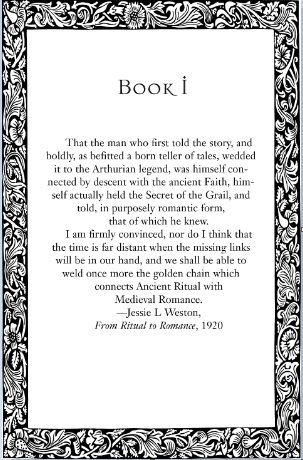
“The first discoverers of gold were prehistoric, well before the civilizations of the Pharaohs of Egypt and the Sumerians,” she says.
But gold soon attracted the admiration of the rich and royal, and since then, kings and emperors, explorers, pirates, and thieves.
“Gold figures prominently in the art and currency of the ancient European civilizations I research. It’s one of the most enduring metals, by every definition of the word,” Stanfill says. “Because of that, the gold jewelry, shoes, vessels and other artifacts unearthed by archaeologists continue to tell their stories centuries later.”
Stanfill shares some other precious golden nuggets:
• Jason and the Golden Fleece, myth or reality?
Roman historian, Strabo(1st century B.C.) wrote about villages by the Kuban River in the Ukraine, where gold collectors used sheepskins to trap the fine gold particles in the rivers and streams flowing from the Caucasus Mountains. The skins could then be dried and beaten to shake out the gold dust. This practice continued well into the 20th century. It’s very possible Jason and the Argonauts sailed to Colchis, a kingdom on the Black Sea, searching for gold. They most likely heard about this wondrous process from other seafarers and traders.
• Why so popular for so long?
One of the reasons gold has been valued since prehistoric times is, frankly, its beauty. The gleaming yellow metal has a color and brilliance unmatched in the mineral world. Another reason is that the world has precious little of it. In all of history, just less than 364 million pounds have been mined. Only 5.5 million pounds a year are mined now.
• The stuff of classic fashion.
Evidence of ancient art in contemporary architecture, sculpture and other designs is all around us. But nowhere is it as surprising to see as in modern jewelry. Choker-style necklaces made of rigid metal, so popular today, date back to the 8th century B.C. They were a multi-cultural phenomenon, worn in some societies by men and in others by women. For the Celts, they were a symbol of strength and power, and ancient Celts were often identified by the torques they wore not only around their necks but around their waists and wrists (bracelets!)TerryStanfillAuthor Studies of ancient gold artifacts weaved into new novel.
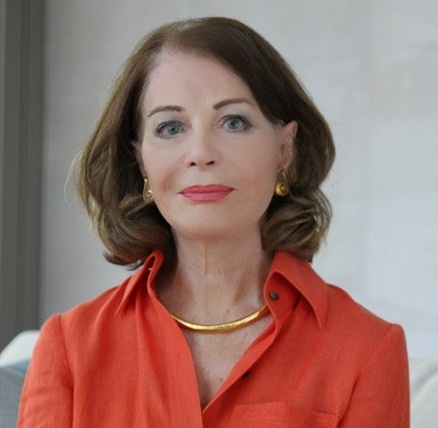
Author Terry Stanfill
Even as modern society hoards gold as a hedge against the volatile world economy and watches as the price per ounce rises and dips, Stanfill says the true value, for her, is in its history.
“Some of mankind’s most beautiful artwork – his very best efforts – were created from gold, and they endure today,” she says. “Without gold, we might not know the status of people found in ancient tombs, and we would not have the vast collection of centuries old artworks that we do today.
“The value of gold that never changes is in how it allows the ancients to communicate with us.”
Terry Stanfill holds a degree in English literature with a minor in medieval history. She is an Overseer of the Huntington Library in San Marino, Calif. An enthusiastic preservationist, she was decorated by the president of Italy with the Ordine al Merito, Cavaliere della Repubblica Italiana, and more recently as Commendatore, for her fundraising efforts for the restoration of San Pietro di Castello, the ancient cathedral of Venice. She is a former international representative for Christie’s auction house and former director of Norton Simon Museum in Pasadena, Calif.
Realms of Gold: Ritual to Romance is her third novel and it has received glowing praise; Kirkus Reviews described it as, “An erudite thriller that recalls Dan Brown’s Robert Langdon series—only smarter.” Stanfill is married to Dennis Stanfill, former CEO of 20th Century Fox and MGM Studios.

Posted by The Silo

If ever gold was precious, it’s now. “Gold has remained at or near record high prices , even while the value of other commodities falls,” notes art expert Terry Stanfill, author of Realms of Gold: Ritual to Romance www.realmsofgoldthenovel.blogspot.com , a book that blends factual ancient art and history with modern, fictional romance.
“This past summer, we were all about the gold – our athletes’ gold medals, which, by the way, had the highest value of any Olympic gold medals in history at $708.”
More than two-thirds of the world’s gold demand is for jewelry, she says, of which the United States is the third-largest consumer, behind India and China.
But Stanfill, who studies ancient gold artifacts and weaves them into her newest novel, says we are hardly the first to become enamored of the rare yellow metal.

“The first discoverers of gold were prehistoric, well before the civilizations of the Pharaohs of Egypt and the Sumerians,” she says.
But gold soon attracted the admiration of the rich and royal, and since then, kings and emperors, explorers, pirates, and thieves.
“Gold figures prominently in the art and currency of the ancient European civilizations I research. It’s one of the most enduring metals, by every definition of the word,” Stanfill says. “Because of that, the gold jewelry, shoes, vessels and other artifacts unearthed by archaeologists continue to tell their stories centuries later.”
Stanfill shares some other precious golden nuggets:
• Jason and the Golden Fleece, myth or reality?
Roman historian, Strabo(1st century B.C.) wrote about villages by the Kuban River in the Ukraine, where gold collectors used sheepskins to trap the fine gold particles in the rivers and streams flowing from the Caucasus Mountains. The skins could then be dried and beaten to shake out the gold dust. This practice continued well into the 20th century. It’s very possible Jason and the Argonauts sailed to Colchis, a kingdom on the Black Sea, searching for gold. They most likely heard about this wondrous process from other seafarers and traders.
• Why so popular for so long?
One of the reasons gold has been valued since prehistoric times is, frankly, its beauty. The gleaming yellow metal has a color and brilliance unmatched in the mineral world. Another reason is that the world has precious little of it. In all of history, just less than 364 million pounds have been mined. Only 5.5 million pounds a year are mined now.
• The stuff of classic fashion.
Evidence of ancient art in contemporary architecture, sculpture and other designs is all around us. But nowhere is it as surprising to see as in modern jewelry. Choker-style necklaces made of rigid metal, so popular today, date back to the 8th century B.C. They were a multi-cultural phenomenon, worn in some societies by men and in others by women. For the Celts, they were a symbol of strength and power, and ancient Celts were often identified by the torques they wore not only around their necks but around their waists and wrists (bracelets!)TerryStanfillAuthor Studies of ancient gold artifacts weaved into new novel.

Author Terry Stanfill
Even as modern society hoards gold as a hedge against the volatile world economy and watches as the price per ounce rises and dips, Stanfill says the true value, for her, is in its history.
“Some of mankind’s most beautiful artwork – his very best efforts – were created from gold, and they endure today,” she says. “Without gold, we might not know the status of people found in ancient tombs, and we would not have the vast collection of centuries old artworks that we do today.
“The value of gold that never changes is in how it allows the ancients to communicate with us.”
Terry Stanfill holds a degree in English literature with a minor in medieval history. She is an Overseer of the Huntington Library in San Marino, Calif. An enthusiastic preservationist, she was decorated by the president of Italy with the Ordine al Merito, Cavaliere della Repubblica Italiana, and more recently as Commendatore, for her fundraising efforts for the restoration of San Pietro di Castello, the ancient cathedral of Venice. She is a former international representative for Christie’s auction house and former director of Norton Simon Museum in Pasadena, Calif.
Realms of Gold: Ritual to Romance is her third novel and it has received glowing praise; Kirkus Reviews described it as, “An erudite thriller that recalls Dan Brown’s Robert Langdon series—only smarter.” Stanfill is married to Dennis Stanfill, former CEO of 20th Century Fox and MGM Studios.

Published on October 15, 2012 00:00
October 12, 2012
Guest Post: 10 Surefire Ways to Succeed in Publishing by Penny C. Sansevieri

Penny C. Sansevieri
Author and CEO
Marketing Experts, Inc.
I've written a lot of pieces on publishing success. I've talked about picking the right publisher, finding an editor, etc. All helpful, for sure, but this time I wanted to dig a bit deeper.
I've been coaching authors for years on publishing, marketing, and idea creation. You name it, I've probably addressed it in a coaching session. The topics I'm addressing in this piece are issues that seem to come up again and again when I'm working with authors and while this might sound more like a goal-setting or Ra-Ra Tony Robbins piece, believe me when I say that often the difference between a successful author and someone who just dawdles on the fringes of success lies in these tips -- so here we go:
Start early: I say this all the time, but clearly I can't say it enough. Start early, get your website up, craft your message, do your research. I've done scads of articles on this topic so I don't want to belabor it, but I did think it was important to start here.
Invest in your success: It's funny how authors often think that being an author doesn't require an investment. Hey, you wrote the book and that should be enough, right? Decide on your investment and then ask yourself: How much money am I willing to lose? Yes, I said lose. You may earn your money back in book sales, but you may not. It's impossible to predict how any book will do so make an investment that you are prepared to lose if things don't go as you'd hoped.
Step out of your comfort zone: Literally I mean get out. Step out. Network. Go to events, listen to speakers, pay the money to go, travel and stay over. Trust me if you pick the right event it will be completely worth it. Why? Because getting out of your comfort zone will not only gain you valuable contacts and networking, but it could also lead to new ideas or a new path that could lead to some additional success. Author events, conferences, whatever you feel is right for your work are fantastic ways to connect with like-minded people in the industry. A lot of folks favor virtual events, I like them too. But there's nothing like sitting in a room with a bunch of folks doing the same thing you're doing to get those creative juices flowing.
Stay focused: This is a big one. Very big. I find in my coaching that the one thing that can separate the successful author from the author who just sort of flounders and does not find his or her way is focus. If you have to work with someone to stay focused it could be the best money you spend -- ever. Let's face it, authors are creative and as such, we have minds that are fertile and active. We have no shortage of ideas, but we do have a shortage of time. Most of us don't have an infinite number of hours to complete everything we want to, that's where focus comes in.
Set clear, definable goals: This ties into focus but deserves its own mention because it's key and very, very important. As with any business or venture, you want goals. Ideally you want to create a list of goals, five or ten at the least, that you wish to attain by publishing your book. Then, once the book is out, what are the goals surrounding your marketing? How many bloggers do you want to reach? How many events do you want to do, etc.? Oh and one final note on goals. Book sales should be at the bottom of your list. Why? Because you won't get sales without exposure and marketing wisdom tells us that people need seven impressions to your book, message, or product before they will consider a buy. Your goals should be aligned with that focus: getting as many impressions or pieces of exposure as you can. Get enough exposure and book sales will follow. It's simple math.
Bring in objectivity: I sort of address this with the team, and later on in being able to take feedback, but trust me when I say that having people on your team who can be objective is often the difference between success and failure. Your family, friends, and neighbors all love you, but the likelihood that they can tell you: "Sorry, this cover really stinks" is minimal. Find someone or a team of people who can be wildly objective, not only can it help you attain your success, it can save you a lot of money in the process. How? By giving you insight, tips, guidance and things that you might otherwise have to learn on your own. Read: the hard way.
Follow similar authors: Success leaves clues. Follow and get to know other authors in your market. This will help you accomplish a few things. First off, authors are very generous and if you're connected with someone who has written in the same genre, I'm betting that he or she is open to giving you guidance, tips, and advice; if not, they are still great to follow and observe. Second, watching what a successful author does will be helpful to you when you're defining your own goals and objectives. And finally, get Google Alerts on the authors you aspire to be like, every time they pop up on a blog comment on the post they've been referenced in and comment or congratulate them on a review or feature. This will get into networking mode with the author and the blogger. The blogs they are featured on might be great contacts for your work, too.
Read your contracts carefully: I am amazed at how often authors just sign up willy-nilly for stuff out of excitement or the need to gain attention for their book. Read the contracts, do the research. Know what you're getting into. You'll be glad you did.
Hire a team and respect them: If you're hiring professionals to help you, remember that you are bringing them in because you need and value their expertise. Respect their work and respect their time. No one can create miracles for a book, least of all a hired team. They work hard, respect that. If things go wrong, don't blame everyone from the person who designed your cover to the guy who sold you your first pencil. Take responsibility for your success or lack thereof. Be proactive and be willing to take feedback. Which brings me to the following point.
Welcome and encourage feedback: I can walk into a room of 500 authors and pick out the ones who will be successful. Is this magic? No. It's called feedback. Authors who are willing to listen and learn and get valuable input to make their work better are often miles more successful than authors who refuse to listen to the advice of professionals who have been in the industry forever. Look, not everyone will be right, but if you respect someone's work, respect their input. Gather this data, then sit with it and see which direction you want to go. Accepting feedback is huge. I've had authors scream at me for not liking their cover. I refuse to feed into an author's ego just to make him or her happy, that's not what people pay me for. You should surround yourself with people who aren't afraid to tell you something you don't want to hear. This will help you more than any ego-stroking in the world.
If you follow all of these tips are you guaranteed success? I'd like to say yes, but success is a very personal venture and means something different to all of us. The tips described in this piece might be the same ones I would suggest to anyone going into business and that's the key. Publishing is a business, packed with the same demands, risks, and success that any business brings with it. Understand the basic principles of business and you've now understood how to be successful in publishing. Not only that, but using a solid model for business will put you light years ahead of most of the other authors out there, and with 300,000 books published a year, you need a strong model in order to succeed. Applying business principles to your campaign can help you do that.

Published on October 12, 2012 00:00
October 10, 2012
Guest Post: Smack Dab in the Middle: Monster! by Royce Buckingham
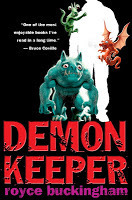
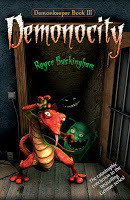
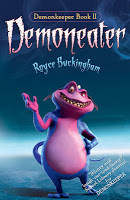
We have always had a fascination with monsters. From the time of the big three—Dracula (vampire), Frankenstein (zombie), and the Wolf Man (werewolf)—to the age of the pretty vampires and sensitive werewolves, Americans have literally eaten up the myth of the monster in all of its forms.
One of the interesting things that has happened over the years is the humanizing of these creatures. The vampire was originally seen as a shambling, grotesque beast returning from the dead to haunt Europeans in their myths and legends. In his movie debut, the vampire was Count Orlock of Nosferatu fame. Here’s a snap:
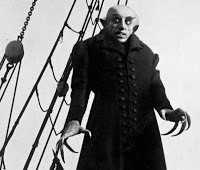
Compare this handsome young man (above) with a modern interpretation of the gruesome beast below:

Weird, huh? The same sympathetic treatment has been given to Werewolves (Patricia Briggs) and even Zombies. These perfectly good monsters who were once mysterious (ie. not understood) have been turned into our neighbors, our BFF’s, and even objects of desire who reveal their inner feelings and have been, it turns out, misunderstood. To that, my question is…where’s the scary?
I guess it’s no secret that many, many, many-many-many, modern YA monsters are not monsters at all, but instead just humans with issues.
When I set out to write a monster story back in 1997 or so, I had no idea that the trend was to personify monsters, anthropomorphize them, if you will. I thought they should just be scary and mysterious and kill you, preferably via eating. For my DEMONKEEPER series, I chose (you guessed it) demons. I took a traditional approach and made the bad monster bad. I had it eat kids, not date them. I chose demons because demons come in all shapes and sizes, and not all are evil; some are just annoying. Thus, I could have my monster and comic relief as well. In this way, I retained the traditional monster and tapped into our visceral, Neanderthal fear of being eaten alive by a wild animal (thank you ancestors), and I was able to play with lesser demons at a lower threat level (“hey dude, don’t virus my ipad”).
But was I watering down the monster myth too?
When I handed in my first draft of my subsequent book, THE DEAD BOYS, to my editor, John Rudolph (then at Putnam), he asked me if I really wanted it to be spooky. “Of course!” I said. He then proceeded to cut half of the book in the first edit. HALF! I just about had a heart attack. Talk about scary. But there was a method to his Mr. Hyde madness. He had cut all of the humor from the book. And the monster (a kid-eating tree) was delivered without any “softening.” It was relentless. It never winked and had a sensitive side. It didn’t joke around with you after school. It-just-ate-you. Period. Evil. Scary. No dating. No prom. No misunderstood-ing. It liked to eat boys. Yum! I rewrote half the book, and darn but if John wasn’t exactly right. It was spookier. Several book awards and fan letters about sleepless nights followed. Check the covers of the DEMONKEEPER series (above) vs. THE DEAD BOYS. Which is spookier?
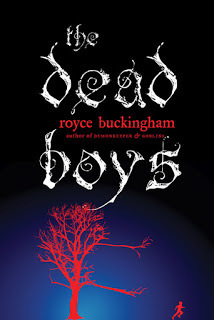
The phenomenon of making monsters relatable and sympathtic is probably a spectrum. King Kong-mammal/sympathic/less scary. Alien-insectile/not sympathetic/very scary. And so there is no right or wrong, just differences in approach and effect. Thus, as a writer, it is important to be aware that the more you understand the beast, the less scary it is. So make choices based upon the tone you wish to convey, before your editor cuts half of your book. As a reader, choose your monsters with this in mind. Do I want a drama with creatures? Do I want a genuinely scary story? I know which I’d choose. But that’s just me. I like spooky.
Boo!
Royce

Published on October 10, 2012 00:00
October 8, 2012
Story Merchant Clients Clint Hill and Lisa McCubbin will be the featured speakers at 7:30 p.m. on Nov. 14 at the STEUBENVILLE, OH Chamber Of Commerce lecture series.
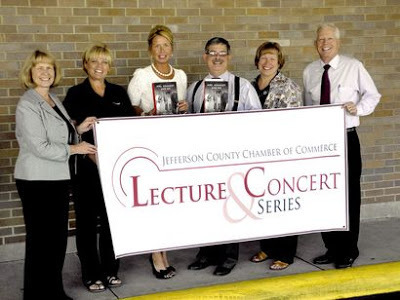
MAKING PLANS — Author Clint Hill, who along with Lisa McCu
Copies of "Mrs. Kennedy and Me" will be available for purchase at the Her ald-Star office. Hill and McCubbin will be available to sign them.
For V.I.P. tickets, which will include a private reception with Hill
and McCubbin and an autographed copy of the book, contact Sue Hershey
(740) 282-6226.
More Details Here

Published on October 08, 2012 00:00
October 6, 2012
An Afternoon and Evening With Author Larry D. Thompson - October 11th 1 and 6 pm - Houston Public Library
Published on October 06, 2012 00:00





